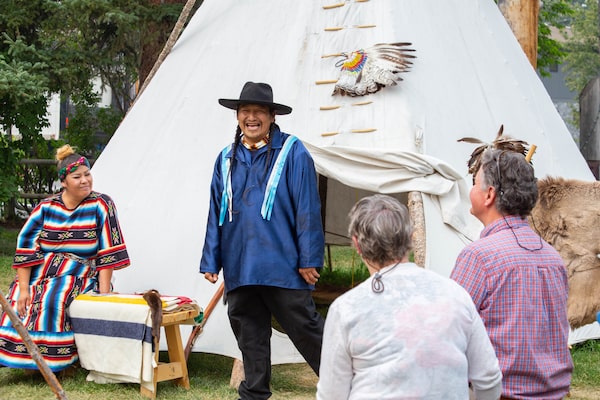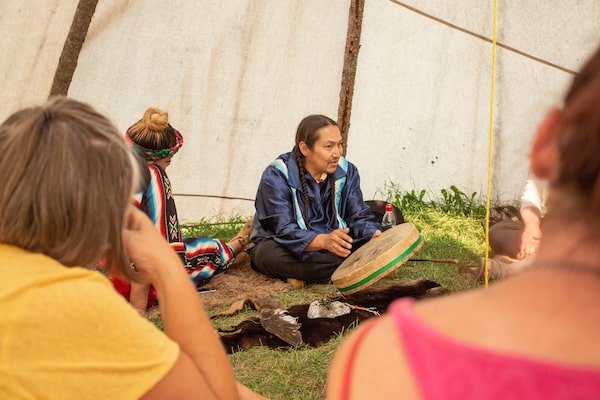
Travis Jimmy John (in the blue ribbon shirt) and Ronine Ryder (seated behind), co-owners of the eco-tourism company, Nakota Îtipi and Ryder Style Crafts, lead the Canmore Museum’s Indigenous Stories program.Handout
One of the historic landmarks in central Canmore, Alta., looks different this summer. The North-West Mounted Police Barracks, a historical site run by the Canmore Museum, no longer stands alone. Next to the 1893 structure that once served as worksite, police lodgings and a jail, a large tepee was erected in late June.
As part of the museum’s new vision, visitors now encounter something new inside the barracks as well: acknowledgment of the role the police played in Canada’s traumatic Indigenous history. This includes forcibly removing children from their homes and sending them to residential schools, and overseeing and monitoring the Pass system, which limited movement for Indigenous people from reserves.
“We don’t shy away from talking about that,” says the museum’s executive officer, Ron Ulrich. When asked what sort of presence Indigenous history previously had at this site and at the Canmore Museum itself a few blocks away, Ulrich was blunt. “None,” he said.
“We feel museums should play a big role in reconciliation, in presenting the truth. That’s our job.”
The Canmore Museum could be held up as an example of how small museums in Canada are evolving to better represent Canadian history by including Indigenous contributions and perspectives. Community museums across the country are working to adapt programming and exhibitions so they are more representative of the Indigenous community. Where once visitors learned only about pioneer life, watching white interpreters churn butter or work in the blacksmith shop, they are now, in some museums, also meeting Indigenous elders and learning about what they faced when settlers came here.
For instance, the Burnaby Village Museum in Metro Vancouver – with installations that include settlers’ homes and businesses, as well as a tram, church and movie theatre – opened the Indigenous Learning House in 2019, which is staffed by an Indigenous education team. Its creation “represents a watershed moment in history for Burnaby Village Museum and our commitment to the process of reconciliation,” stated its 2019 annual report.
The Truth and Reconciliation Commission called for changes involving museums, including a call to action that the Canadian Museums Association receive federal funding to undertake a national review of museum policies and best practices, in collaboration with Indigenous people.
The CMA established a reconciliation council in 2018 and is in the third year of a three-year project to deliver a report and recommendations. It has surveyed museums and Indigenous-run cultural heritage centres, conducted an academic literary review and has been holding listening circles with Indigenous communities. The CMA has found in general that while there is a willingness and desire to work with museums, there is also “frustration stemming from a lack of Indigenous representation and partnership in museum spaces, colonial approaches to shared work, and … slow or denied repatriation of Indigenous belongings,” reports spokesperson Rebecca MacKenzie.
Which points to the critical importance that these changes at settler-narrative museums should be guided by Indigenous people themselves – in the community and at the museum, with more diversified staff and board members, and volunteers. Repatriation – the return of Indigenous ancestral human remains and objects – must also be part of the process, say experts, including the BC Museums Association, which issued a repatriation call to action in May.
“I think across the country and the world perhaps there has been a lot more frank and more open discussions about the need to … include Indigenous voices and recognize our collective history – the uncomfortable conversations,” says Koy Tayler, the BCMA’s Indigenous outreach and partnership co-ordinator, who is of mixed settler and Métis ancestry. “That of course has bled into the museum and cultural sector.”
As devastating as the pandemic has been for small museums, it has also presented an opportunity to focus on this while doors had to be closed to visitors.
“We wouldn’t have been able to do this work [otherwise],” says Ulrich, who joined the Canmore Museum in July, 2020.
Down the highway in Banff, the Whyte Museum of the Canadian Rockies was also able to use the forced shutdown for good. “It was kind of a pause for reflection,” says Whyte Museum chief executive officer Donna Livingstone.
The Whyte Museum, out of necessity, began to focus more on nature and the outdoors – which is central to the institution’s raison d’être. “The pieces in our collection are reflective of that love of nature, that passion for this landscape,” Livingstone says. “So it’s not a leap at all; it makes sense. It’s in our DNA.”
As a result, its Heritage Gallery has been cleared out, allowing for better views through its windows. Outside, picnic tables have been painted by Dene and Stoney Nakoda artists. Welcome messages have gone up in seven languages; Indigenous-led nature walks are planned for the spring; and work has begun on a project about traditional Indigenous trade routes in the Banff area.
This is all in addition to a years-long project that has been happening in the Whyte Museum’s archives.
Going through photographs, archival assistant Dagny Dubois noticed something: “how many historical images we have of Indigenous people and how crazy it was that there were so few that had names attached to them,” she explains. The white people in the photos would be identified, often with detailed information, but the Indigenous people would be labelled simply as “Indian or Chief or the S-word, something along those lines,” Dubois says. “It really kind of smacked me in the face.”

The Canmore Museum recently erected a tipi next to its Northwest Police Barracks in the Bow valley and is completely changing the focus of the museum to include the Stoney Nakoda.Handout
That was the birth of the Recognizing Relations project, which aims to identify Indigenous people in the photos. Since 2014, when Dubois partnered with Corleigh Powderface of the Stoney Nakoda Nation, more than 540 photos have been scrutinized. People have recognized themselves, their parents and other family members.
Many of the photographs come from Banff Days, when Indigenous people would dress up in regalia, and some identifications have resulted from recognizing beadwork, or the regalia – even a horse.
Dubois was stunned by the carelessness – whether by the photographers or original archivists. As an example, she points to a series of photos in which an Indigenous person is identified as John Hunter. “One of them was a woman, one of them was a completely different person. If you put them all beside each other you would think how can anyone think all these people was one guy?”
While correcting a historical wrong, she feels the act of identification brings dignity back to these people – while also creating access for their descendants. “It’s the respectful thing to do,” Dubois says. “A way the institution can make things right. That’s what this project is: We’re just doing what we should have been doing.”
New labels, exhibitions and wall panels can’t accomplish this seismic shift in a vacuum. Dawn Saunders Dahl, the Whyte Museum’s Indigenous program manager, says long-followed processes at cultural institutions need to be re-examined and reworked. “That’s what for me decolonization is. It’s breaking down the barriers and really understanding what has gone wrong and why and making sure that Indigenous voices are embedded permanently.”
And while these are some positive examples, Saunders Dahl, who is also curator of Indigenous public art for the Ottawa Public Library and the Library and Archives Canada’s joint facility, says there is still a long way to go. She says meaningful listening is key to this process.
“I’m so surprised at the shock people have around residential schools. Elders have been saying that for years,” says Saunders Dahl, whose Stoney Nakoda gifted name is Âba Thâ Wîyâ. “Why this is a shock to so many Canadians still baffles me.”
In Canmore, the museum and NWMP Barracks have become home to living memorials for victims of residential schools. People in the community have brought children’s shoes and other items, following revelations of unmarked graves at residential schools.
Formerly the Canmore Museum and Geoscience Centre, the institution revealed a new strategic direction in April. Once focusing on the local coal mining history, “there is so much more to tell,” its mission statement says.
“Oftentimes for small museums it’s all about the taming of the Wild West – you know, the railway came through, our town came to be, the museum tells the story of their community,” Ulrich says. “We forget that there’s another 10,000 years of lived experience in that area.”
There are other changes, too, including a proper land acknowledgment and welcome message at the museum entrance. A temporary exhibition space is being created for Indigenous stories; one of the first exhibitions will be about powwows, created by the Red Deer Museum + Art Gallery in Red Deer, Alta. Even the gift shop has changed, with new offerings such as books by Indigenous authors. An online portal, called Stories that Matter, will launch in August.
Ulrich stresses that there is much more work to be done, including the goal to establish an official memorandum of understanding with the Stoney Nakoda. “This is a journey,” he says. “The systemic issues that are being faced by Indigenous communities as a result of our forbearers’ actions cannot be undone in one summer, or even four years.”
Sign up for The Globe’s arts and lifestyle newsletters for more news, columns and advice in your inbox.
 Marsha Lederman
Marsha Lederman